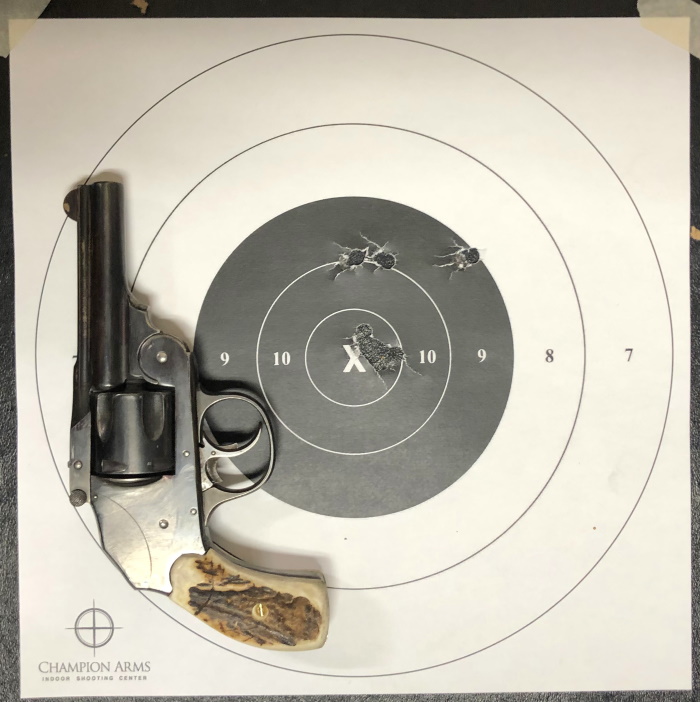

The pistol is considered safe in this state as the "double-action" pull that both cocks and fires the firearm is both longer and heavier than the "single-action" pull that simply releases the cocked hammer, and thus an inadvertent trigger pull is less likely.
#Iver johnson top break revolver trigger doesnt reset manual
Most traditional double-action semi-automatic (DA/SA) pistols are designed to be carried with the hammer down (uncocked) on a chambered round, with or without a manual safety engaged. Gripping the pistol tightly is all it takes to disengage the safety. As the Ortgies is a pocket pistol meant for personal defense, this feature eliminates the problem of failing to disengage the safety when one needs to shoot. Thus, engaging the safety also relieved some tension in the striker spring. The lever then would latch in the disengaged position until the user released it again by pressing a button under the slide, whereupon tension from the striker spring would push it back to the engaged position. To disengage the safety, a user would squeeze a lever until flush with the rear of the grip. Finally, if both the grip is squeezed and the trigger pulled simultaneously, the pistol will fire.Īnother, unusual variant was found in the Ortgies semi-automatic pistols. Alternatively, the trigger can first be pulled and then it will fire when the grip is subsequently squeezed. When the grip is released, the firearm is decocked, and the single-action trigger will not cock the firearm, therefore it will not fire unless the grip is squeezed and the trigger pulled. The firearm is cocked and ready to fire only when the front of the grip is squeezed by the operator. When disengaged (in), it remains latched until the button under the slide is depressed.Ī related grip-type safety is the decocking grip found on some H&K pistols like the P7 Series. Ortgies pistol with grip safety engaged, visible extending right from the upper part of the grip. The Uzi submachine gun is another example of a firearm with a grip safety. The M1911 design is a popular example of a handgun with a grip safety. It is usually similar to a manual safety in its function, but is momentary the safety is deactivated only while the shooter maintains their hold on the grip, and is reactivated immediately once the shooter releases it. These are the oldest forms of "active" safety mechanism and are widely used however many "double action" firearms such as revolvers do not have manual safeties as the longer, harder trigger pull to cock and fire double-action provides adequate trigger safety, while keeping the firearm in a more ready state.Ī grip safety is a lever or other device situated on the grip of a firearm which must be actuated by the operator's hand, as a natural consequence of holding the firearm in a firing position, in order for the firearm to fire. Designs of such safeties are as varied as the designs of firearms themselves, but the two most common mechanisms are a block or latch that prevents the trigger and/or firing mechanism from moving, and a device that disconnects the trigger from the firing mechanism of the firearm. The most common form of safety mechanism is a switch that, when set to the "safe" position, prevents a pull of the trigger from firing the firearm. 1.5 Bolt interlocks and trigger disconnects.Other devices in this category are trigger locks, bore locks, and gun safes. These integral locking mechanisms are intended as child-safety devices during unattended storage of the firearm-not as safety mechanisms while carrying. Some firearms manufactured after the late 1990s include mandatory integral locking mechanisms that must be deactivated by a unique key before the gun can be fired. Thompson submachine gun) or may have the safety integrated with the mode selector as a fire selector with positions from safe to semi-automatic to full-automatic fire (e.g. Sometimes these are called "passive" and "active" safeties (or "automatic" and "manual"), respectively.įirearms with the ability to allow the user to select various fire modes may have separate switches for safety and for mode selection (e.g. Safeties can generally be divided into subtypes such as internal safeties (which typically do not receive input from the user) and external safeties (which typically allow the user to give input, for example, toggling a lever from "on" to "off" or something similar). In firearms, a safety or safety catch is a mechanism used to help prevent the accidental discharge of a firearm, helping to ensure safer handling. For the main article about firearm safety education, see Gun safety.Ĭlose-up shot of a safety of an M16A2 rifle. This article is about the mechanical safety devices built into most firearms.


 0 kommentar(er)
0 kommentar(er)
